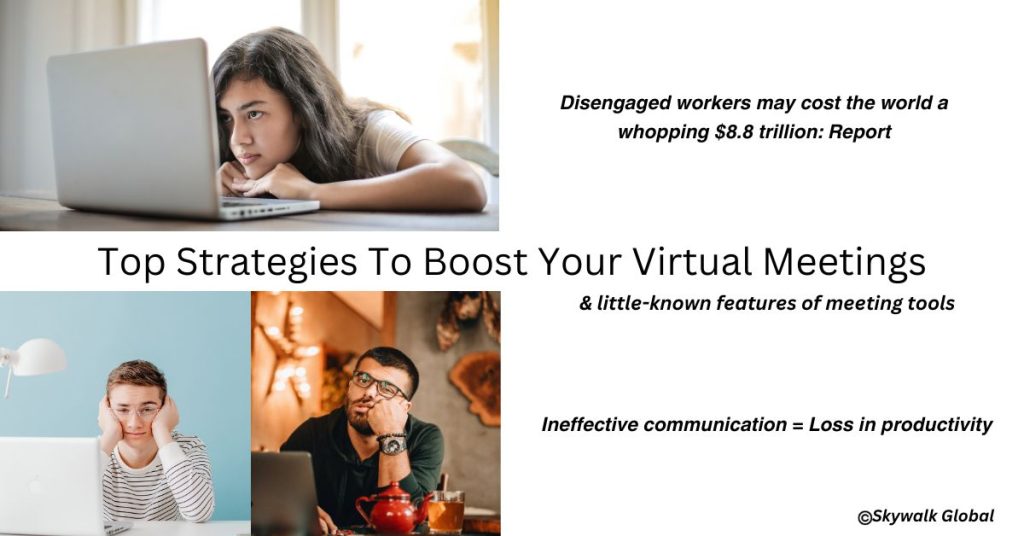Boost Your Virtual Meetings: 7 Communication Strategies & Cool Features of Meeting Tools
The Harris Poll’s survey for Grammarly, The State of Business Communication 2023, says 72% of business leaders believe effective communication enhances team productivity.
On the other hand, Gallup’s State of the Global Workplace: 2023 Report, states that disengaged workers may cost the world a whopping $8.8 trillion in lost productivity.
Effective communication in remote teams is even more challenging than face-to-face interactions because teams are diverse and geographically dispersed. Therefore, lack of communication leads to missed deadlines and project failures.
Problems such as connectivity issues, miscommunication due to the absence of non-verbal cues, language and cultural barriers in global teams, scheduling conflicts across time zones, data breaches from inadequate security measures, lack of engagement among participants etc. critically hampers efficiency.
So, remote teams need to implement smart, empathetic and inclusive online communication strategies and leverage top communication tools for enhanced productivity, stronger relationships within the team, and ultimately greater success in achieving their goals.
7 Effective Tips for Virtual Team Meetings
Here are the 7 best communication tips that will help your team navigate virtual meetings seamlessly:
- Clarity in Communication: Use straightforward and inclusive language and be concise to avoid so that everyone gets what is being communicated.
- Set Clear Expectations: From the start, establish communication frequency, response times, and preferred channels to communicate.
- Select Appropriate Channels: Select the right tool for each situation (email, chat, video) to streamline communication.
- Active Listening: Practice active listening during virtual meetings and use visual cues to show engagement. A positive attitude and cheerful disposition always help!
- Video Meeting Etiquette: Maintain eye contact, dress professionally, and mute your microphone when not speaking. Also, be respectful of cultural diversity and practice restraint during disagreements.
- Time Management: Respect time zones and schedules to coordinate meetings effectively. Join meetings on time and inform if you’re delayed. Also, try to organize the meeting agenda considering the time-limit and do not stretch it unnecessarily.
- Collaborate Securely: Utilize cloud-based document sharing and prioritize cybersecurity measures like strong passwords and encryption.
Did You Know About These Cool Features of Meeting Tools?
Here is Skywalk Global’s list of cool features in some best communication tools that you might not be aware of. These features help in better communication skills and are accessible, inclusive, and empathetic.
- Microsoft Teams – Speaker Coach: Microsoft Teams hasa feature called “Speaker Coach” that provides real-time feedback on the pace, tone, and clarity of your speech during virtual presentations, helping users improve their communication and presentation skills.
To access: Go open a meeting in Teams, click the ellipsis (…) in the meeting controls, and turn on “Speaker Coach.”
- Google Meet – Polls: Google Meet offers a feature to conduct polls during meetings. This helps engage participants, gather real-time feedback, and make data-driven decisions.
To access: You can start or join a Google Meet video call, click on the “Activities” tab, select “Polls,” and then enter a poll question, set up options, and finally click “Launch” to initiate the poll.
- Zoom – Breakout Rooms: Zoom’s Breakout Rooms feature allows the host to split participants into smaller groups for more focused discussions, facilitating effective communication within larger meetings.
To access: Start or join a Zoom meeting, click the “Breakout Rooms” button in the meeting controls, and then set up and manage breakout sessions as required.
Some interesting things to know about other communication tools:
- The Webex app has a gesture recognition feature that can identify and react to hand signals, making non-verbal communication more intuitive during virtual meetings.
- GoToMeeting allows participants to use drawing tools, making it easier to annotate and highlight information on shared screens or documents for more effective communication.
- Skype for Business provides live subtitles during calls and meetings, improving accessibility and communication for participants with hearing impairments or language barriers.
- Google Slides has a feature called “Voice type speaker notes,” which allows you to dictate your speaker notes using your voice. It is only available on computers using the Chrome web browser.
By implementing these communication strategies and utilizing the lesser-known features of common meeting tools, you can maximize productivity during virtual meetings. Remember to evolve your strategies to adapt to the changing landscape of work and collaboration in the digital age.
(Shivangi Singh is a writer with Skywalk Global)
